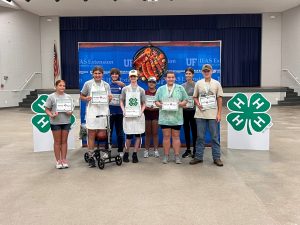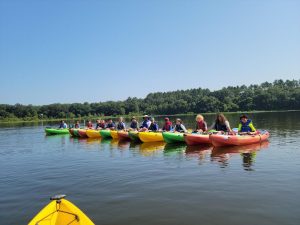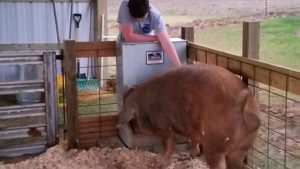by Heather Kent | Jun 13, 2025
 Andy Franklin is one of our newest UF/IFAS hires from Jackson County Florida. Currently interning at the Washington County Extension Office, and serves as their new Media Specialist, providing photography and videography coverage of camps and district events as well as providing some much needed aid in website development to make our 4-H Panhandle sites more user friendly. Raised in Graceville Florida, Andy
Andy Franklin is one of our newest UF/IFAS hires from Jackson County Florida. Currently interning at the Washington County Extension Office, and serves as their new Media Specialist, providing photography and videography coverage of camps and district events as well as providing some much needed aid in website development to make our 4-H Panhandle sites more user friendly. Raised in Graceville Florida, Andy comes from a rich agricultural background. Having both of his parents being Ag teachers, Andy grew up participating in 4-H and the Graceville FFA Chapter. During his senior year of high school, Andy participated in the dual enrollment program at Florida Panhandle Technical College, where he took the Digital Video Technology course with his instructor Paul Goulding. Andy discovered a passion for video editing and photography and proceeded to further it through his years at Chipola College, and the University of Florida, the later of which he will graduate with a Bachelors degree in Agriculture Education and Communication, in May of 2026.
comes from a rich agricultural background. Having both of his parents being Ag teachers, Andy grew up participating in 4-H and the Graceville FFA Chapter. During his senior year of high school, Andy participated in the dual enrollment program at Florida Panhandle Technical College, where he took the Digital Video Technology course with his instructor Paul Goulding. Andy discovered a passion for video editing and photography and proceeded to further it through his years at Chipola College, and the University of Florida, the later of which he will graduate with a Bachelors degree in Agriculture Education and Communication, in May of 2026.
by Dana Stephens | Jun 10, 2025
With compasses in hand and determination in their hearts, four dedicated Okaloosa County youth took home top honors at the 2025 Florida 4-H Forest Ecology Contest — a testament to months of tireless preparation, deep curiosity, and unwavering teamwork.

The 2025 Okaloosa 4-H Forest Ecology Team composed of Kaden Thames, Izzy Wise, Philip Thames, and Kayleigh Thames (left to right).
Philip Thames, Kayleigh Thames, Caden Wise, and Izzy Wise didn’t just show up to compete — they showed up ready. Armed with an impressive knowledge of Florida’s forests, these young naturalists spent countless hours mastering everything from bird calls to tree identification, map reading, and the ecological impact of pests and diseases. Their hard work paid off in the forested grounds of Austin Cary Forest near Gainesville on May 29, where they competed with youth from across the state.
In a field where every detail matters and every skill tested, the Okaloosa team rose to the challenge — and then some.
- Philip Thames, one of the youngest contestants, stood out in the junior division for his poise, knowledge, and attitude.
- Kayleigh Thames captured third place overall in the individual, intermediate division.
- Izzy Wise earned an impressive second place overall in the same division.
- Together with Caden Wise, the trio won third place in the intermediate team competition.

Okaloosa 4-H youth won third place in the team, intermediate division at the 2025 Florida 4-H Forest Ecology Contest. The team included Kaden Wise, Izzy Wise, and Kayleigh Thames presented by Red Baker, Director of UF’s SNRE Department (left to right).

Izzy Wise won second place and Kayleigh won third place in the individual, intermediate division at the 2025 Florida 4-H Forest Ecology Contest.
But this wasn’t just a win on the scoreboard. This year’s victory was deeply personal. The team competed in memory of Sheila Dunning, beloved UF/IFAS Okaloosa County Extension Agent and their devoted coach, who passed away earlier this year. Her legacy of mentorship and passion for forestry education continues to inspire each of them.

T-Shirt worn by Okaloosa 4-H youth at the 2025 Florida Forest Ecology Contest in honor of their mentor and coach the late Sheila Dunning.
More than just a contest, this journey was about growth — intellectual, personal, and communal. It showcased the power of 4-H to shape youth into thoughtful, capable leaders rooted in a love for science and the natural world.
Congratulations to our Okaloosa 4-H team! Your hard work, heart, and humility have made your community proud.

by lauenc | Apr 8, 2025
Growing Through Responsibility: 2025 Northwest District 4-H Chick Chain Show Recap
On March 29, 2025, youth from across the Florida Panhandle came together to celebrate months of dedication, learning, and hands-on experience through the annual Northwest District 4-H Chick Chain Show hosted by UF/IFAS Extension. More than just a poultry show, this event reflects the core values of 4-H—Head, Heart, Hands, and Health—in every pen, project book, and presentation.
Head: Learning by Doing
The 4-H Chick Chain Project begins months before the show, with youth receiving baby chicks in the fall. From day one, they commit to learning everything they can about poultry breeds, nutrition, safe handling, biosecurity, and daily care. Through record books and activities like the Skill-a-Thon and Avian Adventures, 4-H’ers apply critical thinking and build knowledge in animal science and agriculture.
Skill-a-Thon Winners:
Junior: 1st – Julia N. (Calhoun), 2nd – Issac M. (Holmes), 3rd – Henry F. (Jefferson)
Intermediate: 1st – Sawyer K. (Gadsden), 2nd – Edward S. (Jefferson), 3rd – Kiera B. (Calhoun)
Senior: 1st – Cayman B. (Calhoun)
Avian Adventures Winners:
Junior: 1st – Lilah H. (Gadsden), 2nd – Collin O. (Washington), 3rd – Aubrey M. (Washington)
Intermediate: 1st – Brylee H. (Gadsden), 2nd – Tate C. (Jackson), 3rd – Julia M. (Santa Rosa)
Senior: 1st – Andrew M. (Santa Rosa), 2nd – Emmit A. (Holmes), 3rd – Felicity M. (Calhoun)
❤️ Heart: Confidence and Compassion
At the heart of 4-H is youth development—teaching young people to care for something beyond themselves and to take pride in their accomplishments. Showmanship is where this shines the brightest. Youth not only present their birds, but also demonstrate patience, sportsmanship, and pride in their work. They cheer for each other, encourage their peers, and grow in confidence with every word.
Showmanship Winners:
Junior: 1st – Saylor W. (Washington), 2nd – Kara O. (Gadsden), 3rd – Julia N. (Calhoun)
Intermediate: 1st – Kaydence A. (Holmes), 2nd – Julia M. (Santa Rosa), 3rd – Landon B. (Calhoun)
Senior: 1st – Andrew M. (Santa Rosa), 2nd – Felicity M. (Calhoun), 3rd – Emmit A. (Holmes)
Hands: Practical Skills for a Lifetime
From building coops to managing a feeding schedule, 4-H Chick Chain participants gain real-world experience and valuable life skills. They also have the chance to learn about entrepreneurship and animal husbandry through competitions like Best of Breed and Production classes.
Best of Breed:
Australorp – Remington G. (Holmes)
Brahma – Lucas S. (Washington)
Cochin – Rowan C. (Gulf)
Maran – Cannon B. (Washington)
Orpington – Blake M. (Washington)
Plymouth Rock – Joseph B. (Gadsden)
Rhode Island – Jud P. (Holmes)
Sussex – Aubrey M. (Washington)
Wyandotte – Jackson J. (Washington)
All Other Breeds – Felicity M. (Calhoun)
Production Champions:
Grand Champion – Emma W. (Washington)
Reserve Champion – Easton S. (Calhoun)
Health: Building a Better You and a Better World
The Chick Chain experience promotes responsibility, goal-setting, and personal growth. Caring for animals daily encourages healthy routines, attention to detail, and a deeper understanding of how humans and animals thrive together. It also promotes community involvement, connecting youth with agriculture and food systems in meaningful ways.
Overall Champions:
Reserve Champion – Caroline F. (Wakulla)
Grand Champion – Felicity M. (Calhoun)
As this year’s Chick Chain season wraps up, we’re reminded that 4-H is more than ribbons and rankings—it’s a journey of personal growth, skill-building, and connection to the world around us.
Interested in being part of the next Chick Chain project? Enrollment for the 2025-2026 4-H year begins in September 2025! Reach out to your local 4-H agent to learn how to get involved and start your own poultry adventure.
#4HGrowsHere #ChickChain #4HFlorida #HeadHeartHandsHealth #PoultryProud #YouthInAg
To view or download photos provided by Chris Lauen, Holmes County 4-H Agent, and the Northwest District 4-H Chick Chain Commitee, view the online photo gallery by clicking the following website link: 2025 NWD 4-H Chick Chain.
by lauenc | Aug 6, 2024
2024 4-H Northwest District Tailgating (Grilling) Contest Results
The 2024 4-H Northwest District Tailgating (Grilling) Contest was a great success and served as a platform to showcase the grilling talents of youth from various counties. This event is part of the broader Florida 4-H Tailgating Contest program, that aims to promote the safe preparation of animal proteins and develop valuable life skills in youth. The 2024 Florida 4-H District and State Contests are sponsored by Publix Super Markets and Sonny’s BBQ.
Program Overview
The Florida 4-H Tailgating Contest encourages participants to grill different types of proteins, including beef, pork, poultry, and shrimp. Youth compete at county and district levels, with top performers advancing to the state competition. The Contest also requires participants to create a tabletop display to show off their recipe and creativity. Participants may use a laptop/iPad/poster & easel to complement their tabletop display to describe their recipe. The overall program emphasizes the development of grilling skills, highlights food and fire safety, and promotes healthy lifestyle choices.
2024 CONTEST RESULTS
Beef Category

- 1st Place: Cate B. (Okaloosa)
- 2nd Place: Jade L. (Liberty)
- 3rd Place: Sydney G. (Escambia)
- 4th Place: Charlie B. (Gadsden)
Pork Category

- 1st Place: Taylor A. (Escambia)
- 2nd Place: Josh W. (Washington)
- 3rd Place: Brogan B. (Holmes)
- 4th Place: Malec C. (Liberty)
Chicken Category

- 1st Place: Tucker P. (Escambia)
- 2nd Place: Braden P. (Escambia)
- 3rd Place: Kylie T. (Bay)
- 4th Place: Emmit A. (Holmes)
Shrimp Category

- 1st Place: Chipper M. (Holmes)
- 2nd Place: Jeb W. (Gadsden)
- 3rd Place: Hunter S. (Escambia)
- 4th Place: Cheyanne H. (Gadsden)
Prizes
Winners in each category were awarded as follows:
- 1st Place: $400
- 2nd Place: $250
- 3rd Place: $100
- 4th Place: $50
State Competition
The top two winners from each category will advance to the Florida 4-H Tailgating State Contest on October 5, 2024, at the Animal Sciences Beef Teaching Unit in Gainesville, FL. Participants will have the opportunity to compete for further recognition and scholarships.
State Contest
For each protein category:
- 1st Place: $1,500
- 2nd Place: $1,000
The Florida 4-H Tailgating Contest not only provides a competitive platform but also equips youth with essential life skills, fostering a healthy lifestyle and decision-making abilities (Florida 4-H) (UF IFAS Extension). For more information about the District Contests and the State Contest, contact your local 4-H Agent and visit Tailgate Contest – Florida 4-H – University of Florida, Institute of Food and Agricultural Sciences – UF/IFAS (ufl.edu).
by Prudence Caskey | Jul 25, 2024
The origins of county fairs can be traced back to the late 18th and early 19th centuries. The first recognized county fair was held in 1811 in Berkshire County, Pittsfield, Massachusetts. The Berkshire County Fair exhibited produce, livestock, and other agricultural commodities. Throughout the 19th century, the popularity of county fairs spread across the agricultural communities in America. The fostering of community spirit and camaraderie. County fairs’ economic impact has benefited local communities, with exhibitors traveling into town to showcase their wares. Fairs were about more than rides and funnel cakes initially. It wasn’t until 1893 when George Ferris invented and showcased the Ferris wheel at the Chicago World Fair, that rides became part of fairs. But are fairs really still relevant today?
Fairs are a place where youth can demonstrate the knowledge and skills they have developed through their project work in 4-H. There are three ways youth can do this at a fair: 1. Exhibit non-animal project work, 2. Exhibit an animal they have raised, and 3. participate in a judging contest.
Exhibiting Non-Animal Project Work– Exhibiting what you learned in your project is a culminating experience for 4-Hers. Youth can exhibit plants they have grown, preserved foods, things they have sewn or crafted, or photos or posters about their projects. Adult exhibitors sometimes enter a separate competition by showcasing quilts and baked goods or bringing in their prized roses. As fairs grew, many businesses decided to showcase their new products. Early fairs were the place to find the newfangled washing machine, refrigerator, or even a new tractor!
 Exhibiting Animals– Raising a livestock project can be a valuable source of life lessons and teachable moments, even though many people may not initially consider it as such. A 4-H member is making a serious commitment when they sign up for a livestock project. A commitment to their parents or grandparents who helped purchase the animal. They must be committed to completing the project and the record book. Mostly, that child is seriously committed to the animal they are raising.
Exhibiting Animals– Raising a livestock project can be a valuable source of life lessons and teachable moments, even though many people may not initially consider it as such. A 4-H member is making a serious commitment when they sign up for a livestock project. A commitment to their parents or grandparents who helped purchase the animal. They must be committed to completing the project and the record book. Mostly, that child is seriously committed to the animal they are raising.
Youth can learn much from a livestock project—confidence, responsibility, empathy, goal setting, financial responsibility, and sportsmanship. Livestock projects at county fairs can range from raising a bantam chicken to raising a 1,200-pound steer. Each project can teach youth valuable life skills. In 1952, E.B. White published a book about youth raising livestock for the county fair called “Charlotte’s Web.” In the story, the little girl raises a pig for the county fair, growing up alongside the pig, Wilber. It is highly recommended if you have not read the book or seen either of the movies.
 Competing in Contests– Most fairs offer subject matter specific contests where youth can demonstrate their project knowledge. In the Florida Panhandle, there are contests for Horticulture Judging, Wildlife Ecology, Sewing, Consumer Choices, Science, Technology, Engineering, and Math (STEM), and Agriculture. During these contests, youth use what they have learned to problem solve, communicate, and work as a team. Next time you hear the fair is in town, enjoy the corn dogs and cotton candy, but remember the exhibit hall. You may run into a 4-H club member caring for their animal or watering their plants in the horticulture exhibit.
Competing in Contests– Most fairs offer subject matter specific contests where youth can demonstrate their project knowledge. In the Florida Panhandle, there are contests for Horticulture Judging, Wildlife Ecology, Sewing, Consumer Choices, Science, Technology, Engineering, and Math (STEM), and Agriculture. During these contests, youth use what they have learned to problem solve, communicate, and work as a team. Next time you hear the fair is in town, enjoy the corn dogs and cotton candy, but remember the exhibit hall. You may run into a 4-H club member caring for their animal or watering their plants in the horticulture exhibit.
For more information on 4-H, please contact your local 4-H office. You can find your local office here.
https://nwdistrict.ifas.ufl.edu/4hn/2021/03/04/meet-the-author-prudence-caskey/
Prudence Caskey, Santa Rosa County 4-H Agent II
by Valerie Mendez Stansly | Mar 21, 2024
Setting off on a paddling adventure with youth, whether it involves canoeing, kayaking, or stand-up paddleboarding (SUP), offers a wonderful opportunity for them to get active, connect with the outdoors, and learn the value of teamwork. These activities can leave a lasting impression on the young people involved, fostering feelings of accomplishment, resilience, and fellowship. However, the responsibility on the adults leading these trips is significant. Ensuring a safe, educational, and enjoyable experience requires meticulous planning, a focus on safety, and a commitment to engaging each participant. Through this blog series, you will be provided with the insights and tools necessary to organize a successful paddling event for youth.
Securing Kayaks
Safety is the foundation of any successful paddling adventure, especially when involving young people. A critical, yet often overlooked, aspect of this safety is the secure transportation of your kayaks. Begin by firmly attaching your kayaks to your trailer using suitable straps. Before hitting the road, double-check that the straps are tightly fastened, the ends are securely tied off, and the kayak doesn’t move when you gently rock it.
When loading a kayak, always position the straps in advance. It’s a team effort to safely lift the kayak by its bow (front) and stern (back) handles—remembering to bend at the knees to protect your back. Once the kayak is evenly placed on the trailer’s crossbars, secure it properly by using the appropriate ties. Although ratcheting straps are commonly used, they can potentially damage your kayak due to excessive pressure. As an alternative, the use of buckle bumper straps offers a safe and user-friendly solution for both novices and experienced paddlers alike. Ensuring your kayaks are safely secured not only protects your equipment but also ensures the safety of everyone on the road.
Planning is Essential – Crafting a Float Plan
The backbone of a smooth paddling adventure is a detailed float plan. This document should outline your route, expected weather conditions, participant list with emergency contacts, and a timeline of the trip. Utilizing resources such as the Coast Guard Float Plan Central website ensures you don’t miss any critical planning steps. Your float plan should include not only the basics but also specific details such as the equipment each person will bring, health forms, expected departure and return times, access points, and the driving route. It’s also vital to assess and document the day’s weather, tides, water flow, and temperature, alongside local regulations, necessary permits, and the nearest emergency services and outfitters.
In addition to creating a comprehensive float plan, it’s essential to pack necessary items like water, snacks, sunscreen, and first-aid supplies, while encouraging lightweight packing to minimize the physical load on paddlers. Ensure that agents and other adults in charge involved are well-informed about the float plan, current and forecasted weather conditions, and the personal skills and comfort levels within the group.
Remember, the float plan is not just a list; it’s a snapshot of your group’s capabilities, equipment, and safety resources. Items not directly related to trip planning and participant safety should be recorded separately. Always leave the float plan with someone on shore who is familiar with the trip details, participants, and local area. This person’s responsibility is to alert local authorities should the group not return as scheduled. Typically, float plans are best entrusted to an agent and/or county extension director.
When you are out on the water, pay close attention to changing weather conditions. If the weather gets challenging, ensure your group stays together and maintains steady communication. In the case of unexpected thunder, lightning, heavy rain, or strong wind, find a protected area on land for the group to escape the elements. If the group gets off the water, be sure that boats or boards are far away from the water’s edge. Make sure to take all paddles and any food, water, and personal gear are with youth.
Choosing the Right Gear
Personal gear and preparedness are crucial for the success of your paddling trip. When choosing a paddling outfit, prioritize versatility, durability, and protection against cold, and wet conditions. Here are some key guidelines:
- Personal Flotation Device (PFD): Always wear a PFD while on the water. Ensure it fits snugly without riding up over your face or head. If adjustments are needed, do so safely onshore.
- Temperature Considerations: Youth and adults should dress for potential immersion. Hypothermia, a dangerous drop in body temperature, can occur in water temperatures as “warm” as 70 degrees Fahrenheit, according to U.S. Coast Guard. Conversely, hyperthermia results from overheating, often due to hot, humid conditions. Dressing in layers will help adjust for body temperature changes during the trip.
- Sun Protection: Applying sunscreen is critical for preventing sunburn and overheating, even on cloudy days. Due to the reflective nature of water, apply sunscreen often. Mineral sunscreen, with zinc oxide or titanium dioxide, forms a barrier against UV rays with a reduce risk of irritation or allergic reaction and is favored by many paddlers.
- Avoid cotton and restrictive clothing: Steer clear of cotton clothing such as jeans and hoodies, which retain water when wet. Instead choose garments made from quick-drying, moisture-wicking synthetics, or wool, which provide insulation even when wet. Fortunately, outfitting yourself appropriately doesn’t have to break the bank—many of these items can be readily found at affordable prices in secondhand stores like Goodwill.
By following safety guidelines and preparing with the right gear, paddlers can enjoy a safe and comfortable experience on the water, ready to face varying temperatures and conditions with confidence. In the next blog, we will discuss group management and safety considerations to take while on the water.

Introducing youth to the joys of paddling can create unforgettable memories that last a lifetime. At the same time, it’s crucial that we, as adults, prioritize their safety above all.
Resources:
Want to learn more? Check out Paddle TV on YouTube which has made great videos in partnership with the American Canoe Association (ACA) by following this link: https://americancanoe.org/education/youth-paddling-development/educational-videos/
Consider using the Paddle Safe Paddle Smart (PS2) curriculum that has been created by ACA when implementing a paddling component during day camps or workshops.
 Andy Franklin is one of our newest UF/IFAS hires from Jackson County Florida. Currently interning at the Washington County Extension Office, and serves as their new Media Specialist, providing photography and videography coverage of camps and district events as well as providing some much needed aid in website development to make our 4-H Panhandle sites more user friendly. Raised in Graceville Florida, Andy
Andy Franklin is one of our newest UF/IFAS hires from Jackson County Florida. Currently interning at the Washington County Extension Office, and serves as their new Media Specialist, providing photography and videography coverage of camps and district events as well as providing some much needed aid in website development to make our 4-H Panhandle sites more user friendly. Raised in Graceville Florida, Andy comes from a rich agricultural background. Having both of his parents being Ag teachers, Andy grew up participating in 4-H and the Graceville FFA Chapter. During his senior year of high school, Andy participated in the dual enrollment program at Florida Panhandle Technical College, where he took the Digital Video Technology course with his instructor Paul Goulding. Andy discovered a passion for video editing and photography and proceeded to further it through his years at Chipola College, and the University of Florida, the later of which he will graduate with a Bachelors degree in Agriculture Education and Communication, in May of 2026.
comes from a rich agricultural background. Having both of his parents being Ag teachers, Andy grew up participating in 4-H and the Graceville FFA Chapter. During his senior year of high school, Andy participated in the dual enrollment program at Florida Panhandle Technical College, where he took the Digital Video Technology course with his instructor Paul Goulding. Andy discovered a passion for video editing and photography and proceeded to further it through his years at Chipola College, and the University of Florida, the later of which he will graduate with a Bachelors degree in Agriculture Education and Communication, in May of 2026.














 Competing in Contests– Most fairs offer subject matter specific contests where youth can demonstrate their project knowledge. In the Florida Panhandle, there are contests for Horticulture Judging, Wildlife Ecology, Sewing, Consumer Choices, Science, Technology, Engineering, and Math (STEM), and Agriculture. During these contests, youth use what they have learned to problem solve, communicate, and work as a team. Next time you hear the fair is in town, enjoy the corn dogs and cotton candy, but remember the exhibit hall. You may run into a 4-H club member caring for their animal or watering their plants in the horticulture exhibit.
Competing in Contests– Most fairs offer subject matter specific contests where youth can demonstrate their project knowledge. In the Florida Panhandle, there are contests for Horticulture Judging, Wildlife Ecology, Sewing, Consumer Choices, Science, Technology, Engineering, and Math (STEM), and Agriculture. During these contests, youth use what they have learned to problem solve, communicate, and work as a team. Next time you hear the fair is in town, enjoy the corn dogs and cotton candy, but remember the exhibit hall. You may run into a 4-H club member caring for their animal or watering their plants in the horticulture exhibit.